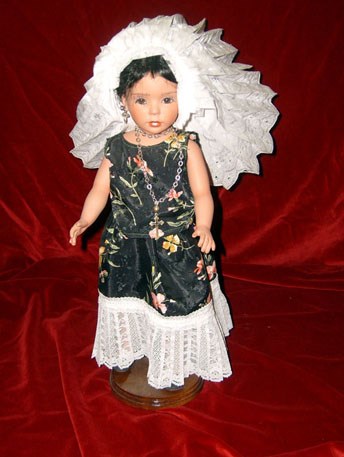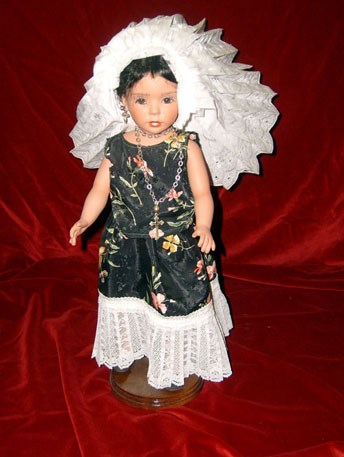
Capital: Oaxaca The sleeveless flowered huipil (tunic) covers a skirt with a broad heavily starched white eyelet flounce around the hem. Another perfectly matched, pleated flounce frames the face. This distinctive headdress - called a huipil grande, resplandor or bidaniro - was actually a child's baptismal gown and is worn by the Istmenas, women from the region of the Isthmus of Tehuantepec. The state of Oaxaca is the site of numerous extremely diverse indigenous groups. Some are related, but all have distinct differences in language and customs. A partial list of the principal groups - distributed throughout the seven regions of Oaxaca, from remote mountain areas to the coast - includes Chatinos, Chinantecos, Cuicatecos, Huaves, Mixes, Amuzgos (some groups are from the state of Guerrero), Mixtecos, and Zapotecos. The language barrier is immense. The Zapotecos alone have more than 20 variations of their language - at times, they struggle to communicate among themselves. In many parts of the state, agriculture is still rustic and many people move to large cities to find employment. Oaxaca is one of the most mountainous states in Mexico, traversed by three great sierras: the Sierra Madre del Sur, the Sierra Madre Oriental - also known as the Sierra de Oaxaca - and the Sierra Atravesada. Rushing rivers and high mountains combine to create beautiful waterfalls and the narrow passages of the Oaxacan canyons. The Chimalapas forest is home to a large variety of plant and animal species. Oaxaca is one of Mexico's largest producers of mango and coffee. Other major crops are corn, beans, sugarcane, lemon, orange, alfalfa, barley, avocado, pineapple, rice, cantaloupe, watermelon, maguey, and tobacco. The state produces a significant amount of gold annually and its mines and quarries also yield silver, lead, copper, zinc, graphite, stone, and marble. Each year, sea turtles visit Oaxaca's shores en masse as a critical part of their life cycle. With their flippers, they scoop out a bit of beach, lay their eggs, bury them, and return to the sea. These animals, an officially protected species since 1990, are in danger of extinction due to the trafficking of their eggs and exploitation of the adult turtles. Oaxaca is home to many extremely creative and skilled artists, including well-knwon painter Rufino Tamayo. Oaxacan handicrafts include indigenous dresses, clay pottery, furniture, and other articles made from palm, wood, leather, and other materials that the indigenous people use in their daily lives. Many Africans entered Mexico through what are now the southern states, including Oaxaca, before migrating throughout the country. Traces of African influence appear in everything from music - the marimba, for example, so popular in Mexican music, has its origins in Africa - to the mulattos, people of mixed race. Did you know...? 
Capital: Oaxaca El huipil floreado sin mangas sobre una amplia falda almidonada con encaje blanco alrededor del dobladillo son características del traje típico de la mujer istmeña, en perfecta armonía con el recargado encaje blanco que enmarca el rostro. Este tocado distintivo, llamado resplandor, era en realidad el vestido bautismal de un niño, ahora es llevado por las istmeñas, mujeres de la región del Istmo de Tehuantepec. Oaxaca, es un estado que alberga diversos grupos indígenas. Aunque algunos se relacionan entre si, todos tienen diferentes costumbres y lenguas. Los principales grupos, distribuidos en las siete regiones del estado, desde las remotas montañas hasta la costa, son: Chatinos, Chinantecos, Cuicatecos, Huaves, Mixes, Amuzgos (algunos grupos pertenecen al estado de Guerrero), Mixtecos, y Zapotecos. La barrera del idioma es inmensa, solo los Zapotecos tienen más de 20 variaciones de su lengua, a veces hasta a ellos mismos se les dificulta comunicarse entre sí. En muchas partes del estado, la agricultura es todavía rústica y mucha gente emigra hacia las grandes ciudades en busca de empleo. Oaxaca es uno de los estados más montañosos en México, atravesado por tres grandes sierras: Sierra Madre del Sur, Sierra Madre Oriental (conocida como Sierra de Oaxaca) y la Sierra Atravesada. Los ríos se precipitan y las altas montañas se combinan para crear cascadas hermosas y estrechos pasajes en los cañones de Oaxaca. El bosque Chimalapas es casa de una gran variedad de pantas y especies animales. El estado es uno de los productores más grandes de mango y café en México. Otras de sus cosechas principales son el maíz, fríjol, caña de azúcar, limón, naranja, alfalfa, cebada, aguacate, piña, arroz, melón, sandía, maguey, y tabaco. El estado produce una cantidad significativa de oro cada año y de sus minas también se extrae plata, plomo, cobre, zinc, grafito, piedra, y mármol. Cada año, las tortugas marinas visitan las orillas de Oaxaca como un aparte importante de su ciclo de vida. Con sus aletas, hacen un hueco en la playa, ponen sus huevos, los entierran y se regresan al mar. Estos animales, especie oficialmente protegida desde 1990, están en peligro de extinción debido al tráfico de sus huevos y la explotación de tortugas adultas. Oaxaca es la casa de artistas sumamente creativos, incluyendo al conocido pintor, Rufino Tamayo. Las artesanías de Oaxaca incluyen vestidos indígenas, cerámica de arcilla, muebles y otros artículos hechos de palma, madera, cuero, y otros materiales que la gente indígena usa en su vida cotidiana. Muchos africanos entraron a México por lo que hoy son los estados del sur, incluyendo Oaxaca, antes de la migración al resto del país. Los rastros de influencia africana aparecen en todo, desde la música (la marimba, por ejemplo, tan popular en la música mexicana, tiene sus orígenes en África) hasta el nacimiento de los mulatos, gente de raza mixta. Sabías que... ? |
Last updated: February 24, 2015
